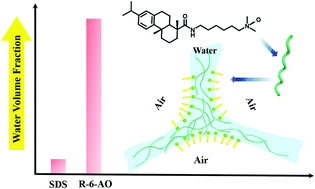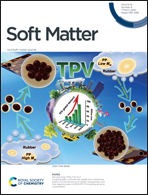Highly wet aqueous foams stabilized by an amphiphilic bio-based hydrogelator derived from dehydroabietic acid†
Abstract
Exploration of novel molecular aggregates that stabilize foam systems is helpful to optimize foam properties. Herein, solutions of a rosin-based low-molecular-weight hydrogelator, abbreviated as R-6-AO, were used to generate foams above the critical gelation temperature (Tgel). The foams with R-6-AO concentrations above the critical gelation concentration were very stable below Tgel. The high stability of the foams under such conditions was attributed to the self-assembly of nanoscale fibers of R-6-AO in the liquid films of the foams, leading to extremely slow drainage of water. The foams showed strong water retention and were classified as very wet foams. For example, the foams generated from 10 mM (0.44 wt%) R-6-AO solution subjected to a fast cooling process contained about 45 vol% trapped water after 2000 min. In comparison, the water volume fraction of a 10 mM sodium dodecyl sulfate (SDS) foam decreased from 20 vol% to 1 vol% within 18 min. Because the growth, elongation, and cross-linking of the assembled nanofibers in the liquid films were affected by the cooling process, the stability of these foams also depended on the initial preparation temperature. The present system reveals the importance of microstructures in regulating foam behavior and serves as a new type of condition-sensitive intelligent foam.



 Please wait while we load your content...
Please wait while we load your content...